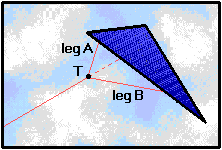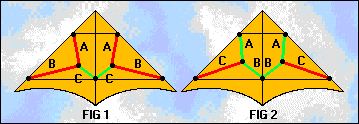
How to get the bridle right

First the most common adjustments assuming the bridle is ok:
> the kite won't take off:
make leg A shorter and leg B longer ( move the towing ring up )
> the kite rises easily but doesn't pull and is unstable:
lenghten A and shorten B ( moving T down )
Specific problems:
> The kite makes a pecking movement with the nose:
the total bridle lenght is too short, make it longer so point T is further away from the kite.
> It's hard to launch the kite, and when it's airborne it overflies you and comes down
Total bridle lenght is too long: shorten both legs so T gets closer to the kite.
The bridle length should be somewhere in between these two points obviously. There is enough room there to consider the following:
Long bridle: bit harder to launch, the kite builds up considerable pull when moving through the window. For a single line kite a long bridle can cause the kite to over react to changes in windspeed.
Short bridle: easier to launch, the kite has a more even pull and can adjust easier to gusty winds.
Dual line kites:

First determine the kind of bridle you have: most European kites are bridled according to Fig 1 ( the long leg runs from top to bottom leading edge connector ) while most US kites have the long leg running from top leading edge connector to the center T )
Basically a stunt kite bridle works the same as a single line bridle. If you look at a Diamond stunter you'll notice it has only the (Fig 2 ) A-B line on both sides. Most dual line kites however have another C line: it pulls the towing point more to the outside. With this line you determine how tight the kite turns.
The problem with adjusting a 2 leg bridle is that you can't change one line without influencing the others: if the towing point is set right so the kite flies ok and you want to change the C line lenght for any reason you'd have to adjust the setting of the towing point again after that... Don't alter existing bridle lenghts when you're in a hurry: it takes a lot of trial and error and time to optimize a changed bridle.
> the kite won't take off:
make leg A shorter and leg B longer ( move the towing ring up )
> the kite rises easily but doesn't pull and is unstable:
lenghten A and shorten B ( moving T down )
> The kite makes a pecking movement with the nose:
the total bridle lenght is too short, make it longer so point T is further away from the kite.
> It's hard to launch the kite, and when it's airborne it overflies you and comes down
Total bridle lenght is too long: shorten both legs so T gets closer to the kite.
> The kite doesn't turn tight enough:
Fig 1: The C leg isn't long enough: lenghten it so the towing point moves more to the tip
Fig 2: The C leg is too long, shorten it so the towing point moves towards the outside.
> When making tight turns the kite slips away sidewards:
Fig 1: The C leg is to long: shorten it so the towing point moves to the center of the kite.
Fig 2: The C leg is to short: lengthen it so the towing point moves to the center of the kite.
If you've built your own design, and have to make a bridle for it the turbo bridle is a good one to start with: it works good on most kites.
What a turbo bridle does
Bridling a kite is always a trade-off between contradictionary demands: you want it to fly fast (high setting), make tight turns (low setting), easy launching (high tow-point) and so on.
The Turbo bridle can overcome some of these contradictions by changing the upper or lower bridle leg lenght as you fly.The idea is to put the towing point as high as possible for an easy launch and good speed, and moving it down while flying tight turns, so the kite tracks well and doesn't slide away.
You can do this by adding a little line between the top legs of the bridle. This line pulls the top legs together, so the towing point is pulled up. When making a turn, the top line on the side you pull will stretch out (lengthen) and the towing point moves down.
The other way is to place the towing point in the line to the center: It's not at the "crossing" anymore but shifted to the center of the kite. If you pull one line the top bridle leg will stretch also, which also lowers the bridling point.
The turbo bridle I use is the one with the line between the top legs: it's mesurements are determined by the lenght of the leading edge of the kite, and will fit most kites with an upper spreader.
 Back to the index
Back to the index




 Back to the index
Back to the index